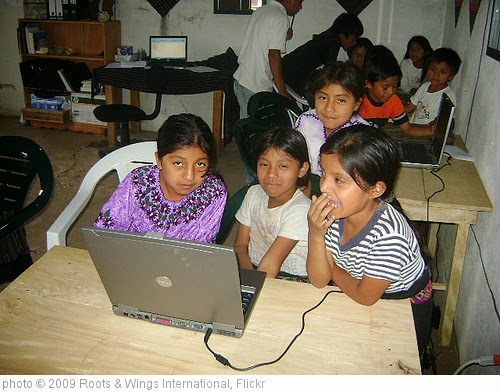This is going to a relatively short “The Best…” list sharing places where ESL/EFL/ELL teachers who are both new and experienced with using educational technology can find resources, ideas, and support.
Here are my picks for The Best Sources For Ideas On How To Use Technology With English Language Learners (not in order of preference):
A video from Nik Peachey called Web 2.0 For EFL/ESL Teachers. In addition, Nik has three excellent blogs focusing on using technology with ELL’s. He’s just put together a second video and e-book with a similar name — Web 2.0 Tools For EFL ESL Teachers.
A good slideshow presentation titled Using Web Logs In The EFL Class. It’s from an English teacher in Greece, Christina Markoulaki,
Language Learning And Web 2.0, a video by Graham Stanley.
The “The Best…” lists I’ve compiled and some articles that I’ve written. The most useful technology-related articles, I think, are:
Samuel L. Jackson, My ESL Students, And Me
Pointing And Clicking For ESL: Using Video Games To Promote English Language Development
Computers And Community Organizing In The ESL Classroom
Thiago Eduardo has a Slideshare presentation on Web 2.0 tools in the EFL classroom.
EFL teachers Gladys Baya and Claudia Bellusci have an excellent Slideshare presentation on Blogs and Wikis.
Learning With Computers is an exceptional group of ESL/EFL teachers from around the world that was begun by Gladys Baya. It’s part of Webheads In Action, which has helped start several similar collaborations. Learning With Computers has a very helpful Wiki and an equally helpful, and active, listserv.
Another great Webheads group and listserv is called evonline.
Members of both Learning With Computers and evonline are from around the world and are extremely open to helping teachers with their questions and challenges.
Two more listservs worth joining are The Computer-Assisted Language Learning listserv from TESL and the National Institute For Literacy’s Technology Discussion List.
TVO Wikispaces has a large list and description of web tools and how to use them with English Language Learners.
Teacher Training Videos by Russell Stannard is a great resources for screencasts showing how to use lots of Web 2.0 applications with English Language Learners.
Last, but certainly not least, on my list is EFL Classroom 2.0. The resources there are too numerous to mention, and the willingness of members to be helpful cannot be over-stated. Few people have helped more ESL/EFL teachers learn about using technology than David Deubelbeiss, founder of EFL Classroom 2.0. David also suggests Mark Pegrum’s eLearning Wiki. He writes, “It is the most complete resource available in my opinion, a kind of directory to everything out there…. Kudo’s to Mark for all his great information and teaching!”
ELT and Technology is the title of a wiki created by David Deubelbeiss of EFL Classroom 2.0. It’s chock-full of useful information.
“The Appropriate Use of Technology in the EFL Classroom” is a nice presentation by Ronaldo Lima, Jr.
36 Tools to Digitise Coursebook Activities is a slideshow presentation by Nik Peachey.
You might also be interested in my Intermediate English class blog, where you’ll find lots of tech-oriented student assignments.
John Paul Loucky also recommends Call 4 All, an extensive collection of technology resources for teaching English Language Learners.
Innovations in Learning Technologies for English Language Teaching is a downloadable book from The British Council.
40th ELT Blog Carnival: Ideas for Teaching with Technology
Innovation in education: looking for learning is by Lizzie Pinard.
Six Cool Tropes in ELT EdTech is by Lindsay Clandfield.
Teaching languages with technology: tools that help students become fluent is by Joe Dale and appeared in The Guardian.
Improving English Fluency and Literacy in English Learners with Technology is from Imagine Learning.
Want our ppt from today’s Using Tech session at #NABE2019?https://t.co/WDzSvQ0cCt@harveyoaxaca @DoDeBoer1 pic.twitter.com/cOhzRhuJrW
— Carol Salva (@MsSalvac) March 9, 2019
Supporting English Learners through Technology: What Districts and Teachers Say about Digital Learning Resources for English Learners is a new report from The Department of Education.
13 FUN CLASSROOM ACTIVITIES USING TECHNOLOGY is from English Teaching 101.
About a year ago @michelleshory & I started https://t.co/ZDlj9xP3BM ❤️to share resources with Ts of ELs. Vocabulary infographic was 1⃣st
👇https://t.co/oAboCqXHLR
I’m thankful for Michelle & my #PLN #Twitter friends. This has been a great year! @MsSalvac @Larryferlazzo #JCPSESL pic.twitter.com/u96gMlEKqy— Irina McGrath, Ph.D. (@irina_mcgrath) November 26, 2019
Help students who are learning English with our Teacher Center training guide. This is a great resource for teachers and school leaders to better support ELL students and their families. https://t.co/VDXk0OcGMg pic.twitter.com/t5yiTdTLfR
— Google for Education (@GoogleForEdu) December 22, 2019
Teaching, Technology, and English-Learners: 5 Things to Know is from Ed Week.
Effects of educational technology on reading achievement for Chinese K-12 English second language learners: A meta-analysis is a new study.
🔗 To infographic pdf:https://t.co/gz0mMqQBFR
— TESOLgraphics (@tesolgraphics) May 26, 2023
🔗 To infographic pdf:https://t.co/caqUr3Ditu
— TESOLgraphics (@tesolgraphics) November 17, 2023
🔗 To infographic pdf:https://t.co/caqUr3Ditu
— TESOLgraphics (@tesolgraphics) November 17, 2023
As always, feedback is welcome.
If you found this post useful, you might want to look at previous “The Best…” lists and also consider subscribing to this blog for free.




Excellent compilation, Larry, as usual! It is implied in the post, but someone should write another list like this including the larryferlazzo.edublogs.org blog
=)
Kindest regards from Brazil!
Ronaldo
Just a further note on EVO (evonline), which consists of 6-week sessions that take place in Jan-Feb annually. The topics are both discussions about aspects of ESL/EFL pedagogy and hands-on use of Web tools and software. The 2009 sessions included Video, Drama, Web 2.0, Conflict Resolution, Images4Education, and so. The full list and descriptions can be found at http://evosessions.pbwiki.com/FrontPage
The next call for participation comes out in early December. The sessions are free, global, and you don’t have to be a TESOL member, although they are sponsored by the CALL Interest Section of TESOL.
Cheers–Elizabeth
Larry,
thanks for the mention! On our community, I really try to teach about technology inductively — meaning put a tool/application up there for members and if they are interested, let them muck about with it and then if they want to go further, start a conversation about it. I think this kind of “sandbox” approach works well with teachers however you still need direct tutorials also.
Teachers can also use our long list of software on our software page (see our directory) http://eflclassroom.ning.com/directory.html
I really love Thiago’s PPT on educational technology !
Thanks again Larry,
David
Dear Larry,
Thank you so much for including my flowgram to your list. I´m constantly mentioning the sources I find by exploring your website and am a huge fan of your work online.
anamariacult
Larry,
One addition I’d make to your so helpful list is Mark Pegrum’s eLearning Wiki. It is the most complete resource available in my opinion, a kind of directory to everything out there…. Kudo’s to Mark for all his great information and teaching!
https://e-language.wikispaces.com/
David
http://eflclassroom.com
I would add iTeach!!! 🙂 Ihttp://iteach20.blogspot.com/
Thank you so much for this on-hand and wealthy E-resources fro EFL teachers who are studying and learning, like me, how to incorporate technology in their classrooms.
Yakitome.com is also very handy with English language learners. I learned of Yakitome.com from your earlier posting about text to speech tools. I use it with my ESL students and it works great. Plus it’s free. Thanks for the links.